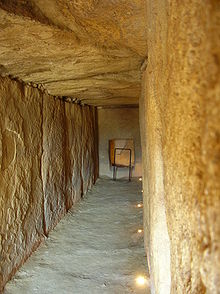- Dolmen de Viera
-
Dolmen de Viera The entrance to the Dolmen de Viera. Location Spain Region Andalusia Type dolmen and tumulus History Material earth and stone Founded 4,000 years bp Periods Copper Age Site notes Archaeologists Antonio and José Viera Ownership Council of Culture, Andalusian Autonomous Government Public access yes The Dolmen de Viera or Dolmen de los Hermanos Viera is a dolmen—a type of single-chamber megalithic tomb—located in Antequera, province of Málaga, Andalusia, Spain.[1] It is located only 70 metres (230 ft) from the Dolmen de Menga[1] and about 4 kilometres (2.5 mi) of another structure known as Tholos de El Romeral. It was discovered between 1903 and 1905 by brothers Antonio and José Viera from Antequera, who also discovered El Romeral.[2]
Like the Dolmen de Menga, it is built with an orthostatic technique: large stones standing upright.[2] It consists of a long corridor[2][3] formed by twenty-seven stones, leading to a rectangular chamber.[2] This is presumed to be a burial chamber, although only silica and bone tools and ceramics were discovered there.[1] The burial chamber has different dimensions than the corridor: a little over 200 centimetres (79 in) high[2] and 180 centimetres (71 in) wide,[4] while the corridor is 185 centimetres (73 in) high[4] and ranges from 130 centimetres (51 in) wide at the entrance to 160 centimetres (63 in) where it meets up with the chamber.[2] The corridor is a bit over 21 metres (69 ft) long.[2] The stones range from 20 centimetres (7.9 in) to 50 centimetres (20 in) in thickness.[4]
The dolmen is covered by a mound or tumulus 50 metres (160 ft) in diameter.[2] Like most Iberian tombs, it is oriented slightly south of east (96º),[2] situated precisely so that at the summer solstices the sunlight at daybreak illuminates the burial chamber.[5]
The left and right sides of the corridor appear to have consisted originally of sixteen slabs each; fourteen remain on the left and 15 on the right. Five larger slabs are intact in the roof, and there are fragments of two others; it would appear that three or four more have been entirely lost. The end of the corridor is a single large monolith with a square hole near its center. This and three other monoliths surround the chamber[2][6] There is a notable difference between the stones of the sides and those of the roof: the former are much more carefully worked and fit perfectly into the recesses made in the stones of the entrance and the floor.[citation needed]
The Dolmen de Viera was built in the Copper Age, over 4,000 years ago in the third millennium BCE; the precise date of its construction is uncertain.[3][7] It has had the status of a Monumento nacional since 1923.[2]
The site is owned by the Council of Culture of the Andalusian Autonomous Government, who manage it as part of the Conjunto Arqueológico Dólmenes de Antequera.[2] The dolmen was restored recently,[4] and is open for visits by the public.[2]
Notes
- This article incorporates information from the revision as of 2010-01-23 of the equivalent article on the Spanish Wikipedia.
- ^ a b c Dólmenes de Antequera, nuevaacropolismalaga.org. Accessed online 2010-01-23.
- ^ a b c d e f g h i j k l m Conjunto Arqueológico Dólmenes de Antequera, Consejería de Cultura, Junta de Andalucía. Accessed online 2010-01-23.
- ^ a b José Antonio Quintana Campos, Dolmen de Viera, Patrimonio Histórico de Antequera «Dolmen de Menga». Accessed online 2010-01-23.
- ^ a b c d Dolmen de Viera, Antequera, Málaga, spanisharts.com. Accessed online 2010-01-23.
- ^ Geoff Garvey, Mark Ellingham, Paul Sandham, Chris Stewart, The Rough Guide to Andalucia, Fourth Edition, Rough Guides, 2003, ISBN 1843530686, p. 108. The book mentions the solstice with respect to the nearby Dolmen de Menga, which is identically aligned; in its case, there is a rock whose shadow is cast by the rising sun.
- ^ A diagram can be seen at Dolmen de Viera, Antequera, Málaga, spanisharts.com. Accessed online 2010-01-23.
- ^ Dólmenes de Antequera, nuevaacropolismalaga.org, accessed online 2010-01-23, says 5,800 to 4,500 years.
Categories:- Archaeological sites in Spain
- Stone Age Europe
- Megalithic monuments in Europe
- Burial monuments and structures
- Death customs
- Málaga Province
Wikimedia Foundation. 2010.


